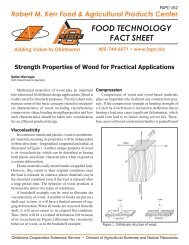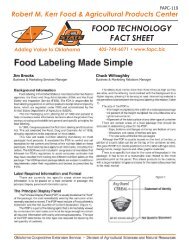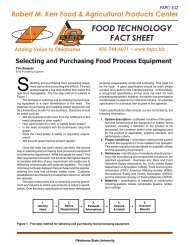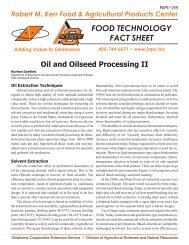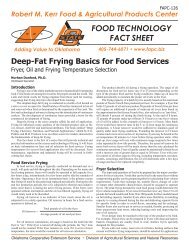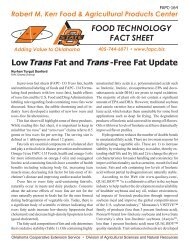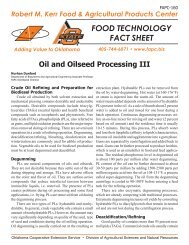Spring/Summer 2010 - Robert M. Kerr Food & Agricultural Products ...
Spring/Summer 2010 - Robert M. Kerr Food & Agricultural Products ...
Spring/Summer 2010 - Robert M. Kerr Food & Agricultural Products ...
Create successful ePaper yourself
Turn your PDF publications into a flip-book with our unique Google optimized e-Paper software.
.<br />
ETC, Haldor Topsoe, Preem, government<br />
agencies, the Swedish Energy<br />
Agency, and the European Union’s<br />
Seventh Framework Program for<br />
Research and Technological Development.<br />
This involves development and<br />
demonstration of a system would integrate<br />
many aspects of advancing DME<br />
as a transportation fuel. The integrated<br />
system would include fuel production,<br />
distribution network, filling stations,<br />
and resources for development of new<br />
engines or modification of current<br />
diesel engines. DME is safe to use as<br />
fuel. In this project, Bio-DME will be<br />
produced from black liquor, a by-product<br />
of paper pulp manufacturing, in a<br />
demonstration plant in Sweden.<br />
According to a press release<br />
by Volvo Trucks in September<br />
2009 (http://pnt.volvo.com/e/get-<br />
Pdf.aspx?id=7643), “In <strong>2010</strong>, Volvo<br />
Trucks will be the first truck manufacturer<br />
to start conducting comprehensive<br />
field tests involving Bio-DME.<br />
Testing is scheduled to run through<br />
2012, and will cover the entire DME<br />
chain, from biomass gasification to the<br />
development of dedicated additives to<br />
experiments using Bio-DME as a fuel<br />
in a fleet of 14 trucks under ordinary<br />
driving conditions.”<br />
In the same press release Mats<br />
Franzén, product manager engines<br />
at Volvo Trucks said, “Volvo’s DME<br />
truck uses a regular D13 engine, which<br />
after some modifications to the tank<br />
system, injection system, and engine<br />
management software, functions perfectly<br />
together with the biofuel. Behind<br />
the wheel, it’s business as usual.<br />
Performance and driving properties<br />
are exactly the same as in the diesel<br />
variant. The difference and the major<br />
benefit with Bio-DME lies in its low<br />
carbon dioxide emissions.”<br />
fuels of the future<br />
By Nurhan Dunford<br />
FAPC Oil/Oilseed Specialist<br />
nurhan.dunford@okstate.edu<br />
DME can be a good alternative fuel to replace<br />
petroleum diesel, but it is important to point<br />
out DME has a number of disadvantages.<br />
In an article published in Fleet-<br />
Owner Newsline, a daily e-newsletter<br />
written for executives and managers<br />
of commercial-trucking fleets,<br />
Jim McCandless of Alternative Fuel<br />
Technologies said, “Although DME’s<br />
energy density is lower than diesel, the<br />
overall engine thermal efficiency is the<br />
same or higher. DME also costs less<br />
than diesel on an equal energy basis;<br />
1.8 gallons of DME will cost less than<br />
1 gallon of diesel, assuming $70/bbl or<br />
higher oil price.”<br />
He also said, “Fuel’s sootlessness<br />
permits the use of very high exhaust<br />
gas recirculation (EGR) rates to lower<br />
oxides of nitrogen (NOx) emissions<br />
without having to use after-treatment<br />
devices such as particulate traps and<br />
Selective Catalytic Reduction (SCR)<br />
catalysts requiring the injection of urea<br />
to lower NOx in the exhaust stream.<br />
Another positive factor, the fuel injection<br />
pressures can be much lower than<br />
are currently needed by diesel engines.<br />
DME engines need injection pressures<br />
of about 6,500 psi, where diesel<br />
engines currently require pressures upward<br />
of 30,000 psi. The lower pressure<br />
requirements greatly simplify the fuel<br />
injection equipment.”<br />
DME can be a good alternative<br />
fuel to replace petroleum diesel, but<br />
it is important to point out DME has<br />
a number of disadvantages.<br />
It has been reported<br />
DME is not compatible<br />
with many types of plastics<br />
and rubbers, which<br />
may lead to valve seal<br />
failure if engine components<br />
are not chosen<br />
properly.<br />
It also is a concern<br />
that DME is significantly<br />
more flammable (lower<br />
flashpoint temperature<br />
and lower auto-ignition<br />
temperature) and volatile<br />
than petroleum diesel.<br />
Additional fuel handling<br />
safety measures need be<br />
implemented to minimize<br />
the potential for fire or<br />
explosion before switching<br />
to DME from petroleum<br />
diesel. DME fuel<br />
tank and fuel lines have<br />
to be grounded to avert<br />
electrostatic charge buildup<br />
and a potential spark<br />
discharge.<br />
Furthermore, DME is<br />
a gas stored in liquid form<br />
under pressure, which<br />
dedicated filling stations<br />
need to be installed.<br />
References:<br />
Troy A. Semelsberger, Rodney L. Borup, Howard L. Greene. Dimethyl ether (DME) as an<br />
alternative fuel. Journal of Power Sources. 156 (2006) 497–511.<br />
André L. Boehman. Developments in production and utilization of dimethyl ether for fuel<br />
applications. Fuel Processing Technology 89 (2008) 1243.<br />
http://fleetowner.com/green/archive/dme-alternative-diesel-0904/?smte=wr<br />
http://pnt.volvo.com/e/getPdf.aspx?id=7643<br />
http://www.thenewsmarket.com/volvogroup<br />
<strong>Spring</strong>/<strong>Summer</strong> <strong>2010</strong> | 11




